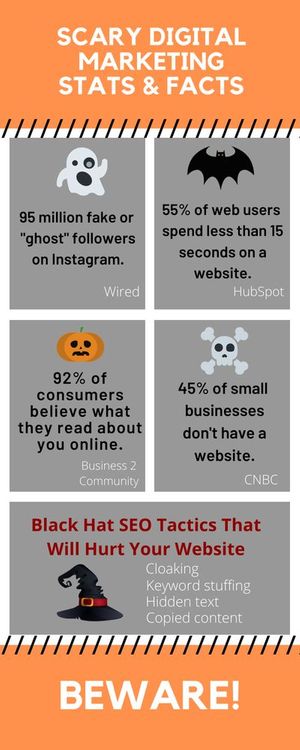Happy Halloween! While most folks look forward to dressing up and bingeing on horror movies and candy, Halloween is also a good time to reflect on the things that scare us most.
Sure, zombies and vampires can be pretty frightening, but we can’t think of anything scarier than fake reviews, spam, slow websites, and downright bad digital marketing tactics.
Despite how outdated and damaging these strategies are, a lot of websites and companies still use them. Are you one of them? Here are four of the scariest digital marketing strategies you may be using, and how you can avoid them once and for all.
1. Non-Mobile Responsive Websites
Smartphones are driving the majority of growth for web traffic around the world, and the need for mobile-responsive websites has become as prevalent as ever. But many websites still haven’t made the move to mobile-responsive design, and it could be hindering their performance in serious ways.
When users are searching for something on the go, they want to retrieve what they’re looking for with ease. A user who has to wait for a page to load, adjust the screen on their device, or endlessly scroll down a page, is more likely to lose interest and click away. A poor mobile experience can make you lose out on potential customers, and can also lead to a higher bounce rate and a lower ranking on SERPs.
Having a mobile-responsive website is also important for another reason. Instead of viewing the desktop version of a web page, Google now only indexes and evaluates the mobile version of the page. This recent update is known as mobile-first indexing, and it is now Google’s default for ranking websites.
The bottom line: If your website isn’t mobile-friendly, you could be scaring prospective customers away and leaving your business in the dark.
2. Fake Reviews & Social Media Followers
Fake reviews and follows are digital marketing tactics that companies, unfortunately, still pay for to bolster their online reputation. And if you’ve tried these tricks, you’ll realize there are no treats at the end of your efforts.
According to Ryan Hickman from NEXT! Ad Agency, publishing fake reviews “looks bad for a company because if they’re willing to be dishonest and cut corners, what else are they willing to do?”
That’s not something you want clients to be asking themselves, and the same goes for your social media marketing. Buying followers and likes might seem like a quick and easy solution, but it won’t do your company any good in the long run. “What’s the sense in fake likes and follows if they don’t help you reach your local audience? Invest your money in ads or content creation because they’ll be more beneficial to improving your bottom line,” says Hickman.
Encourage your clients to review your website or follow you on social media right after transacting with you. Hickman adds, “Make sure the experience is still fresh in their head so they’re more motivated to write about it.”
3. Dead Websites & Poor-Quality Content
Search engines are better at picking up on our natural use of language, and digital marketing strategies like filler content and keyword stuffing have died out as a result (RIP).
As we head into 2020, high-quality content is all the rage as the top-ranking SEO factor. Of course, content still presents the opportunity to rank for trending keywords. But Google and other search engines are looking beyond relevance and placing a greater value on usefulness.
Well-written content that answers questions, offers solutions, and provides new information ranks and performs better. If you have the opportunity to provide a quality link in a contextual manner, do so, but don’t make it your primary focus. The main goal should be creating content that engages readers longer and converts to shares, action, and recurring traffic.
Recent updates to Google’s algorithm have also hit outdated websites, especially those with lower-quality content. If your website is looking ghastly, or is stuffed with fluff, keywords, and broken links, it’s time to revamp it with new content or a blog.
4. Mistargeted PPC Campaigns
Digital marketing tactics, like pay-per-click advertising, can boost traffic to your website and generate sales more quickly. But if you don’t target your audience effectively with strategic keywords on the appropriate channels, you’ll soon find yourself in a nightmare of wasted time and money.
To yield the strongest results, it’s essential to understand your audience and which keywords rank in your region. “Just because a keyword or headline works in one area doesn’t mean they’ll work on the other side of the country,” says Michael Thomas of NEXT! Ad Agency.
With PPC advertising, researching and tracking your campaign is key. Thomas continues, “Google will help us test different ads we’ve made and measure them against each other until we find the best-performing ones. After the first few months, we can tell which keywords are performing the best and we’ll pause the ones that aren’t leading to conversions or have low click-through rates.”
Consider starting a Google Ads campaign with the help of a specialist. That way, you’re targeting the right audience and keywords without missing the mark and losing money in the process.
Start Practicing Better Digital Marketing Tactics
As you pass out candy and enjoy the rest of the holiday, keep in mind that Halloween marks the beginning of the end of the year. With the holidays and new year right around the corner, now is the time to start thinking ahead.
If it’s time to adopt better digital marketing tactics, we can help you map out the best course of action to make 2020 the most successful year yet. Reach out to us and we’ll greet you with a treat!







